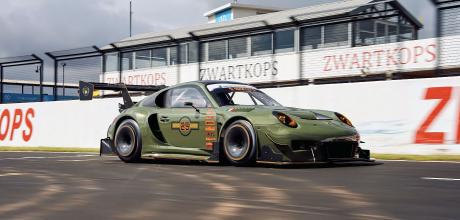Modified 1300bhp Porsche 911 Turbo S 997.2 ‘The General’
Arguably one of the most exciting 911 road-to-race car conversions ever done, we take a close look at the Franco Scribante Racing 997 Turbo S-based race car.
Written by Wilhelm Lutjeharms
Photography by Stefan Kotze
INTRODUCING… THE GENERAL
Modified 911 997 Turbo: ‘The General’
Wilhelm Lutjeharms covers a crazy 997 Turbo-turned-991 RSR, built for the purpose of going racing

The Scribante family in South Africa is synonymous with the local racing fraternity. Either on track or at the annual Simola Hillclimb event, Franco Scribante Racing is there in full force. Not only does the team run modern race cars, it builds its own, complete custom race cars, too. Franco Scribante Racing also has a love for historic racing, running a Chevron B26 in the classic division on this annual hillclimb. Whether it’s a sprint race or an endurance race, you can bet that one of its team members will be participating.
“There’s a lot on this car that you can’t buy off the shelves”
Around six years ago, the team set out to build a race car based on a 997 Turbo S. This is the ideal starting platform, especially since the class (called Extreme Supercars) in which it wanted to enter the car, permits various modifications. This class has a few rules, one of which being that the vehicle must be based on a production model. That means no spaceframe racing specials are allowed. The vehicle must also be a GT car or high-performance saloon car. Other examples of cars eligible for entry include Subarus, BMW M3s, Lotus Exiges, Boxsters and Caymans. Looking at the other cars on the list, it becomes clear that a 911 was the better choice. The constraints of the Extreme Supercars class actually helped to focus the development of the car. Fast forward to March of this year, and it’s now lovingly called The General. Franco Scribante Racing’s conversion set the lap record of 1:08.284 for GT cars (also referred to as tin-top cars) at Killarney International Raceway, which is only a 25-minute drive from Cape Town’s central business district.
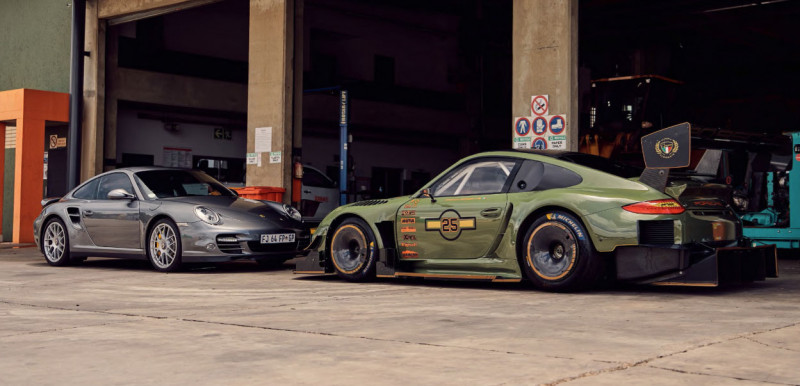
The track is 3.3km in length and features two straights. To place this time in context, a 991 GT3 Cup will lap this track a few seconds slower – which in terms of track time is a lifetime. Just let that sink in for a bit. On another circuit – Zwartkops Raceway outside Pretoria – the team achieved a time of 58.4 seconds, whereas a Ginetta G57 will complete a lap in 59 seconds.
It’s when you take a closer look at The General that you realise not a single element of the car has been left untouched. It grabs your attention more than most standard 911 race cars would. There are numerous air inlets and outlets, a massive wing, an even larger rear diffuser and a front spoiler. The cabin is not only stripped out and pure race car, but there’s evidence of a lot of technology onboard, too. And that’s only some of the visible elements – note those turbo fan wheels, for example! It’s under the bodywork where further developments have taken place over a number of years, which has led to the success this car has finally achieved on the track. With a 997 Turbo S road car parked next to The General, it’s very hard to believe this race car looked exactly like its sibling a few years ago. It’s been a long journey, but this team is eager to share the details with us.
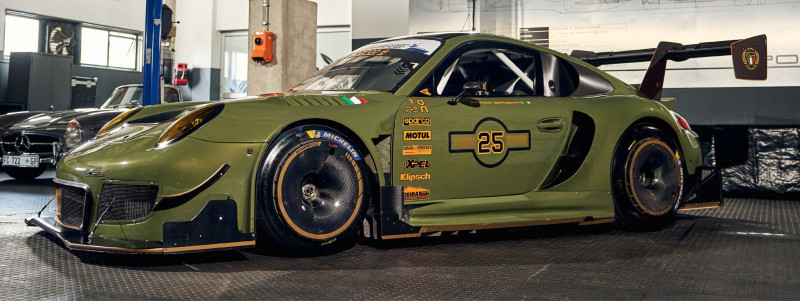
Clean and polished, The General wears its Army green coat with pride following its record-setting time at the track. A car like this isn’t designed with the end result in mind, but is altered over the years as the team learns and improves on the product following track excursions and races. Needless to say, the all-wheel drive system has been binned, and the car is now only rear-wheel drive.
Franco Scribante is both the driver of The General and team owner. He’s been racing all the team’s cars, is a petrolhead and, more importantly, has an appetite for racing and competition.
“Previously, the drivers at the top ran factory GT3 cars that were modified. This will include taking off the restrictors, running on ethanol, adding water methanol as well as improving the cars’ aerodynamics,” says Franco. “This project started because no one believed that we could take on the factory cars with our own creation. It’s taken a few years, because it’s been around six years since the 997 Turbo S left the road. We’re hoping to decimate the opposition this year.”
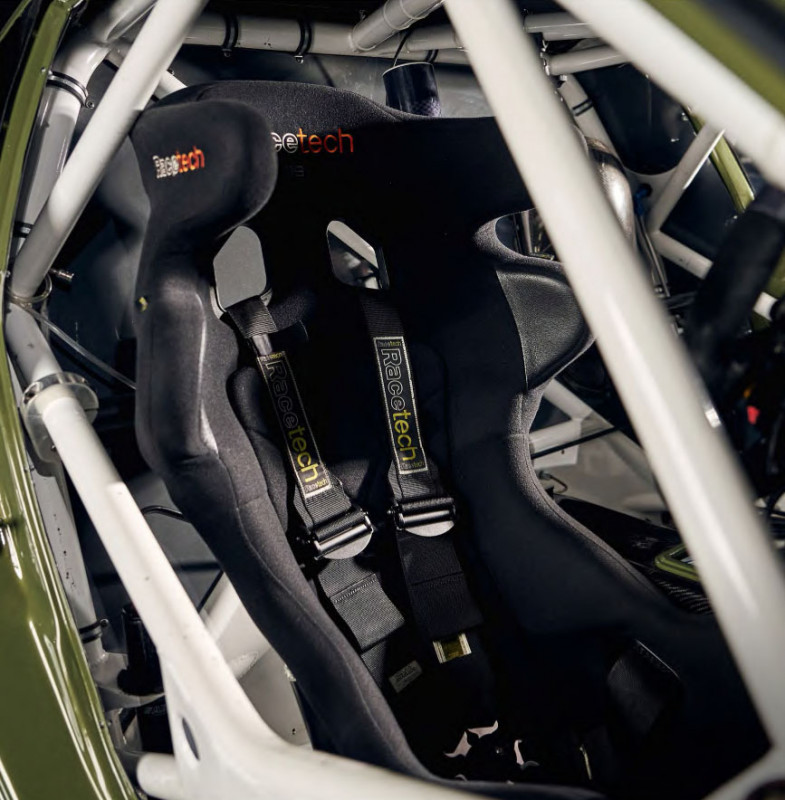
The team is no stranger to 911s and Franco explains the reason they selected one for this project. “We chose the 911 as our foundation, because the platform opens up a variety of opportunities. There are so many custom projects going on around the world, that you can see what’s going on and gain useful information from such undertakings. The result is that we’ve built a car we believe will still be competitive in five years’ time.”
Franco’s clearly pleased with everything that the team has achieved over the years. “There’s a lot on this car that you can’t buy off the shelves. The latest addition, for example, is the turbo fans on the wheels.”
Taking us through the build process is Cobus Jonker, the race manager of the team, who’s also an engineer and engine/gearbox builder. “The first body we fitted was a 2014 GT3 R body, which we imported from Germany,” say Cobus. “From then on we started improving the body and today it’s only the doors and the roof that are still the standard parts as it came from Germany – all the other parts have been modified. This was mainly done for airflow around the car. Getting air into the intercoolers was one of our biggest challenges.”
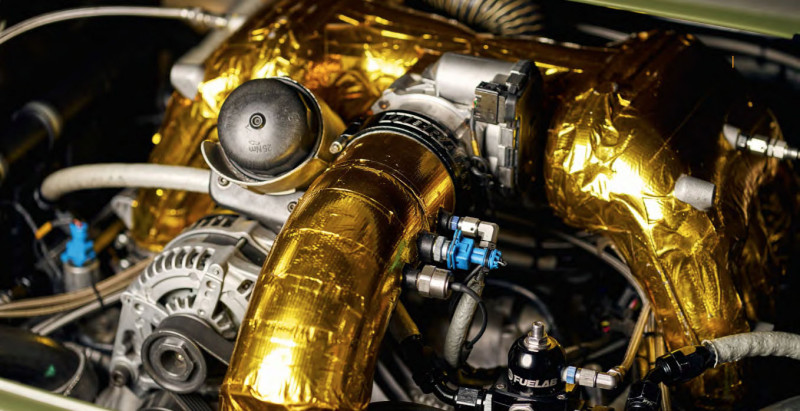
Cobus continues: “In terms of suspension, the car is running on four-way adjustable Penske shock absorbers. I believe we’re now on about the 20th iteration of the valves of these shocks, but I think we’ve found a happy medium. Then there are Eibach springs on the front and rear of the car. In the front we’re running a PWR intercooler and PWR cores for the intercoolers at the back.” We take a closer look, and notice that the front bonnet features an air duct with the radiator, enabling the flow of air over the radiator and out over the windscreen. Move to the rear of the car and you’ll find a custom-manufactured, titanium exhaust system.
However, open the engine lid and it’s an interesting hybrid of a few standard Porsche road car parts, Porsche racing parts and Franco Scribante Racing’s own parts from specialists. “In terms of the turbos, we have Garrett GT30s, but the size is our secret,” says Cobus. “They’re specially designed turbos that we specified for the car. The throttle body is a big 82mm unit. The head unit of the engine was also designed for us, along with a special design for the lifters as well as for the camshaft profile. Other improvements include CP Carrillo connecting roads, CP Carrillo Pistons, special head gaskets and bearings. We’ve also imported a high-performance oil pump from Sweden.” A couple of engines were bought from abroad, but Cobus admits these engines didn’t last until his team became more involved and started to develop the engine themselves with specialists.
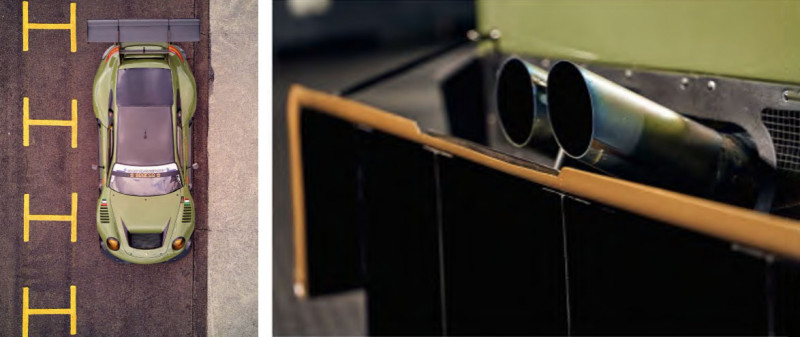
“A MoTec M150 is installed to run the software and the MoTec C125 dashboard manager,” he says. “There are mainly MoTec electronics in this car. We also run ride-height sensors, group sensors, compression sensors and obviously tyre pressure sensors, to name but a few. Apart from that, we also have several other sensors to supply us with information on the state of the car.” Inside, there’s a full roll-cage while the rear quarters of the car is separated from the rest of the cockpit.
“We developed the transmission by working closely with Holinger,” continues Cobus. “At the beginning, there simply wasn’t a transmission that was able to cope with the power and torque of the engine. We started with the MFT transmission. Parts continued to break in the transmission. We’d tell Holinger, send it back to them and they’d soon develop a better part. The result is the MXT, which until now has held up very well. It’s a pneumatic shift, six-speed sequential transmission.”

Before we get to the power figure, I learn that the upgraded braking system features AP calipers on all four corners with 390mm discs at the front and 287mm discs at the rear. Fitting the turbo fans has helped in terms of braking temperatures. “As soon as we put the turbo fans on to the car, I realised that the car is now on the next level, really showcasing all our abilities as a team. In the beginning it was Franco’s idea and he started nagging me to build him a set. I’m so proud of it, and since they’ve been fitted we can really see the effect they have on track, as previously we were struggling with brake temperatures. In addition, they have a more significant impact on the car than simply lowering the temperatures around the braking system.”
After all these years of development, the power delivery of the car must be impressive. Cobus explains: “We had the car on a hub dynamometer. The result was over 1,300 wheel horsepower. We can’t race the car on that amount of power though, so we control this as the car’s speed increases. Essentially, the faster the car goes the better the aerodynamics, which keep the nose of the car down. This feeds back to the software – the higher the car’s speed, the more power we allow the engine to produce.” What does the car weigh? Cobus is reluctant to reveal its true weight, but admits that he’s speaking conservatively when he says the car weighs less than 1,300kg.
This car isn’t about 0-100km/h acceleration stints, but Cobus says that they’ve tested it and have clocked times of 2.6 and 2.7 seconds. As he explains, the car isn’t set up for that at all, but these are, after all, still very impressive times considering it’s on slicks, is a circuit car and the first gear ratio is relatively long. Not forgetting that it’s now only rear-wheel drive. What’s next? Cobus replies by saying a set of magnesium wheels is at the top of his wish list. This will improve unsprung mass at arguably the most important part of the car and will have further handling benefits.
“The most fun challenge was to first get the engine to run reliably and the highlight was when the aero on the car, which was a real trial-and-error exercise by our team, started to work perfectly and we could see the lap times tumble. It’s rather pleasing to prove people wrong who said it couldn’t be done.”
Franco ends with the following promise: “Look, this is an extremely fast car. Even an experienced driver will get out of this car with their eyes very, very wide.” Clearly, more track records will be broken in the next couple of years by The General. And when they do, you’ll be the first to know about it.
ABOVE The General’s mighty rear wing and oversized diffuser help to maintain downforce, keeping the car firmly on the track.
ABOVE This top-down view of Franco Scribante Racing’s masterpiece gives a clearer idea of the aerodynamic shaping and bodywork mods the team has achieved with The General.
ABOVE Turbo fan wheels channel warm air away from the brakes, ensuring they stay cool when The General’s shedding speed on the track, as well as benefiting the car’s overall performance.
RIGHT While the engine can generate over 1,300hp, the car won’t be out on the track with that much power.
ABOVE The custom titanium exhaust pipes have been rerouted so that they now sit above the car’s large rear diffuser.
ABOVE The General being put through its paces at Zwartkops Raceway, on the outskirts of Pretoria, South Africa.
BELOW The driver of The General, Franco Scribante, is enclosed in a full roll-cage, while being separated from the rear of the car.
BELOW A racing steering wheel supplied by OMP sits at the heart of The General’s cabin. BELOW The MoTec C125 dashboard manager feeds crucial sensor data back to the driver.
ABOVE The Italian flag’s colours on one of The General’s vents are a reference to the Scribante family’s heritage.
BELOW The General is light years away from its starting platform: a road-going 997 Turbo S.


